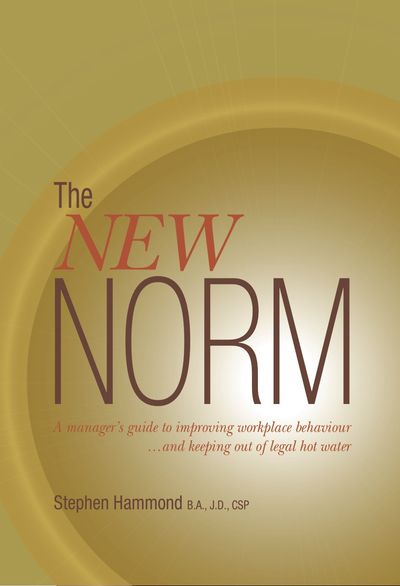Chapter eighteen
THE NEW NORM won’t misuse social media while working
On August 9, 2013, the National Post revealed inappropriate tweets from two City of Toronto firefighters. Matt Bowman was one of those suspended with pay pending an investigation. His tweets involved a picture of him in his firefighter uniform and included, “Reject a woman and she will never let it go.
One of the many defects of their kind. Also weak arms.”; “I’d never let a woman kick my ass. If she tried I’d be like HEY! You get your bitch ass back in the kitchen and make me some pie.”; and “The way to a woman’s heart is through anal.”
Bowman was asked by his employer if there were any other inappropriate tweets and if he had sent any tweets while working. He answered “no” to both those questions. However, the employer got hold of two other batches of tweets, which were “racist, misogynist, demeaning of homeless people and demeaning of people with disabilities.”
Bowman’s union admitted the tweets were inappropriate, and that some were posted while he was working. They also submitted a letter, signed by Bowman, apologizing and accepting how offensive his statements were.
Among many statements of regret, he wrote, “I came to realize that women will never feel comfortable in the [Toronto Fire Service] and will never be able to develop their potential as firefighters, until firefighters like me change what we think and what we say and how we treat our co-workers.” On September 16, 2013, the City of Toronto fired Matt Bowman and his union grieved, sending the matter to binding arbitration.
Part of Bowman’s defence was that he came from a small town, where he was brought up in a “jock culture” and wasn’t exposed to a lot of diversity. But at the age of twenty-seven, he wasn’t a kid anymore and he was working in one of the most diverse cities in the world.
It's clear that this employee could have greatly benefited from taking my Respectful Workplace online course, where we spell out acceptable and unacceptable behaviour at work, including social media wording considered toxic.
There are many times an employee will get his job back if he has learned from his mistakes…and those mistakes aren’t too severe. To help his case, he took “sensitivity” training from a respected member of the labour relations community. This trainer said she felt he became mindful of his comments’ impact and did not feel “he would favour one victim over another in a rescue scenario, due to a discriminatory impulse.”
However, the City was concerned, not just with its reputation, but with what its citizens would think about such a firefighter coming to their assistance. The arbitrator shared that concern when she wrote, “The job involves more than attending at a fire, or attending as the first responder when someone calls 911 for a medical emergency. It involves more than performing the life-saving interventions that he has learned and practiced. The other part of the job, the part that I am not convinced he can perform to satisfaction, is the part that requires him to conduct himself in a way that brings honour to the uniform. I have to wonder if a deaf person, a woman in labour, a homeless person, a member of a visible minority group, apprised of his comments, would welcome this man into their home in a time of need.”
And then we get to the issue of how all this became public: social media. How much is Bowman responsible for simple tweets, which if they had not become front-page headlines of a national newspaper, were likely read by only a few people?
The arbitrator wrote, “When engaging in social media use, it is my view that the user must accept responsibility when the content of his or her communications is disseminated in exactly the manner promoted by the social media provider. This is what social media is intended to do. Once we use these devices, once we load that gun, it is potentially dangerous.”
On November 12, 2014, the arbitrator dismissed his grievance and Matt Bowman was out of a job. She wrote, “A reasonable and fair minded member of the public, if apprised of the facts, would, in my view, consider that the grievor’s continued employment would so damage the reputation of the Employer as to render employment untenable.”
The OLD NORM
- wrote or said whatever he wanted on social media, even while at work and even if depicted in a work uniform.
- didn’t think about the wider implications of information being spread on social media.
- didn’t think he had to adapt to the workplace and clientele around him.
- hopes people will forgive him because of his age and un-worldly experiences.
The NEW NORM
- never misuses social media while at work.
- is willing to engage in provocative discussions (if he wants) on social media, but never makes a connection back to his job.
- realizes an employer or future employer can access a lot of information on social media.
- understands that some of what he writes or says on social media might have an impact, not just on his job, but on the reputation of his employer.
Suggestions for the New Norm:
01
There are constraints on the Web. By no means are issues of social media just a concern for young people. However, many young people have grown up with the Web being a place for the exchange of any and all ideas. We have seen internet and social media companies defend the right of people to say most anything. Hence, it might come as a shock to some employees that there may be consequences to what they post on social media.
02
Learn what “www” really means. Many a judge, adjudicator or arbitrator is upholding the termination of employment of employees when they post inappropriate things on the Web. Saying something bad about your employer or a colleague in a room full of people may do only so much damage. However, when you press “send” on the “World Wide Web,” potentially anyone around the world with access to the Net can find out what you think. The potential for damage is that much greater.
03
Reinforce Web-savviness at work. It’s very likely social media use will increase as it becomes even easier to access (right to our brains soon?). Therefore, it never hurts to educate and re-educate employees about social media’s potential harm.
This chapter lets you know
many people are getting into big trouble with sexist and racist social media posts. For examples of other problems related to social media, consider reading
Chapter 19: The New Norm knows misuse of social media even outside of work is risky.
Purchase a copy of The New Norm, or if you think all your supervisors and managers, could learn many valuable lessons about creating a respectful workplace, free of harassment, bullying and discrimination, you can get volume discounts.
What one reader has to say about Stephen’s book, The New Norm
“Stephen’s book is a brilliant reminder of workplace situations that are disturbing, yet slip by unaddressed by so many in both the private and public sector. When these behaviours are unaddressed, they become the norm because we allow them to be.
Just like his first book, Stephen is insightful, his writing is moving and he inspires his readers to take immediate action to disapprove of, and address harassment and other inappropriate behaviour every time we see it, feel it and hear about it. In a concise format, he gives us a series of snapshots of old vs. new, acceptable vs. unacceptable, right vs. wrong, in a way that is understandable.
If workplace leaders take just some of Stephen’s practical advice, they will go a long way to rid their workplace of unacceptable behaviours such as harassment, discrimination and bullying. It’s clear that to create Stephen’s “New Norm,” we need to ACT NOW! We can’t wait any longer.”
Tatjana Zatezalo
Manager, Organizational Development, Halifax Regional Municipality

Respectful Workplace Online Training Course
If you, your employees or your managers want more information,
sign up for my new online training course:
The Respectful Workplace in Canada.
With 10 modules of useful, relevant and current information,
this course can help everyone at your workplace.
This may be the best online harassment training your people will get.
Stephen Hammond is a lawyer turned speaker and consultant in the field of harassment, sexual harassment, bullying and discrimination at work.
The New Norm is Stephen’s third book.
Here’s more information about Stephen.




